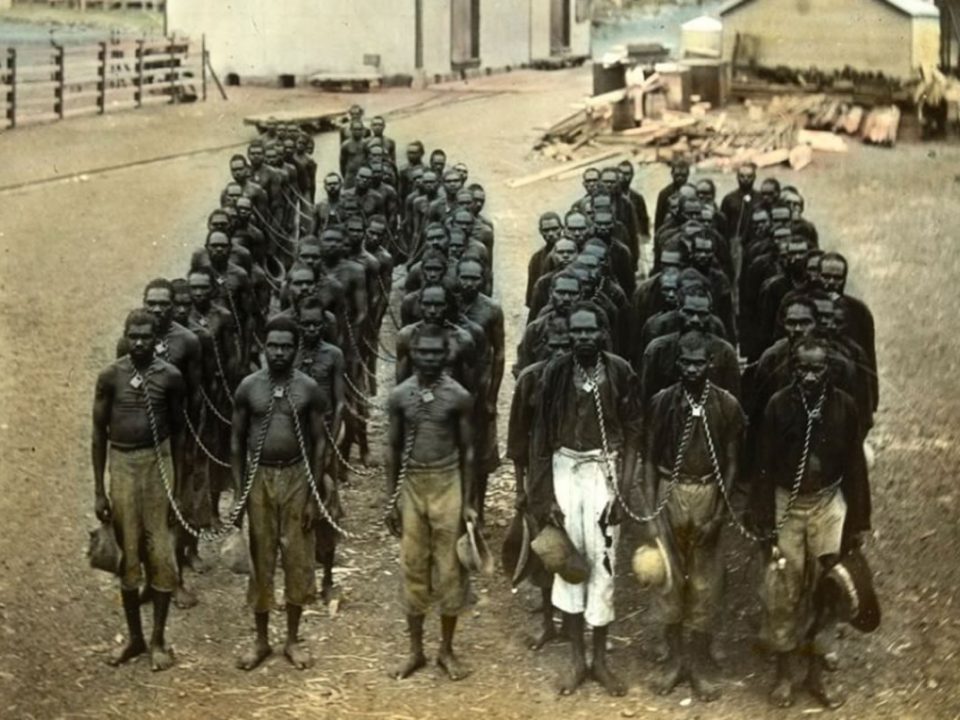‘… The consolidation of colonisation in Western Australia occurred with the establishment of pastoral settlements (sheep and cattle farming) in central coastal regions (e.g. the Gascoyne) from the 1860s, and later in the Kimberley region of the far north from the 1880s.
The Fairburn Report of 1882 highlighted abuses of Aboriginal people by white pastoralists in the Gascoyne region. Aboriginal people working for meagre rations had been made slaves on their own land, in contravention of British law. In the mid-1880s, the Reverend John Gribble reported a range of abuses of Aboriginal people in the Gascoyne, including the widespread practice of child labour, ‘concubines’ being taken by pastoralists, ‘blackbirded’ Aboriginals being supplied by police to the pearling industry, and abuses of the court system where Aboriginal people could be convicted by the uncorroborated word of a single settler, and then sent to the prison on Rottnest Island.
Over time, Wadjemup Rottnest Island, located 18 kilometres (11 miles) west of Fremantle, the current port of Perth, served as a prison for some 3,700 Aboriginal men and boys, many shipped down in neck irons from the central coastal and north west regions of the state.
Due in large part to the adverse publicity, the Western Australian parliament introduced the Aborigines Protection Act 1886, which established the Aborigines Protection Board. None of the Board members were Aboriginal. Local Protectors of Aborigines were appointed to undertake legal proceedings for Aboriginal people. These people, who came from a range of backgrounds, (e.g. Resident Magistrates, Justices of the Peace, Police Inspectors), received minimal renumeration, as the Board had little funding. Presumably, the police acted as both prosecutor and defender of Aboriginal people in some instances!
The effect of the Act was to give increasing power to the Board over Aboriginal people, rather than setting up a system to punish whites for wrongdoing towards Aboriginal people. Many of the regulations were openly flouted in the north of the state. Moreover, injustices continued. As Mary Durack, who appears in our Story, wrote in her enthralling 1959 book Kings in Grass Castles [4]:
‘… no native brought to justice in Kimberly was acquitted nor was any white found guilty on a charge involving the treatment of an aboriginal.’
Given continued criticism, parliament appointed Dr W E Roth, Chief Protector of Aborigines in Queensland, to head a Royal Commission on the Administration of Aborigines and the Condition of the Natives in 1904. Roth’s investigations involved visits to only northern coastal areas of Western Australia, and he interviewed only two Aboriginal witnesses.
However, he detailed a number of criticisms in his Report [5], the harshest being of the police. In relation to their treatment of Aboriginal people accused of cattle-killing, he described ‘a most brutal and outrageous condition of affairs.’ (p. 13)
Roth discovered that Aboriginal children, often as young as ten years of age, were regularly stolen to work in the pastoral and pearling industries, where they were indentured as unpaid and uneducated apprentices. He found a virtual slave system involving Aboriginal children who were taken without the authority of the Aboriginal Affairs Department, and almost certainly without consent of their parents. Roth disagreed with this cruel treatment of Aboriginal children.
In his Report, Roth drew attention to a growing number of people described as ‘half-castes’, saying:
‘… if these are left to their own devices under the present state of the law, their future will be one of vagabondism and harlotry.’ W E Roth, Royal Commission on the Condition of the Natives Report, 1905, p. 25 [5]
Many of these children were conceived as the result of sexual exploitation of Aboriginal women by Europeans and had been abandoned by their fathers. Roth referred to Resident Magistrates and Police Inspectors who thought the children should be taken away. After weighing up the evidence, he decided to recommend that the Chief Protector of Aborigines be made the legal guardian of every Aboriginal and ‘half-caste’ child until the child reached the age of 18 years (p. 26)….’
CONNECTION: Aboriginal Child Artists Captivate Europe. David Clark, in association with John Stanton. Copyright © 2020 by David Clark
You can read more here in the Prologue of the book.


